Failure yeast infection is an infection that is accompanied by a cosmetic defect and a number of clinical symptoms.The pathological changes relate to the layer of stratum of the skin and nail plate.The causal agent of mycoses is representatives of the lower class - mushrooms.The infectious process is dangerous not only for the patient himself, but also by those around him.How to prevent nail mycosis and get rid of infection will be discussed.
Micose nails on the legs - What is it?
The legs on the legs are called onychomycosis and refers to a special classification of diseases.Recently, complaints concerning infection have increased several times.Doctors associate this indicator with an unhealthy ecology.
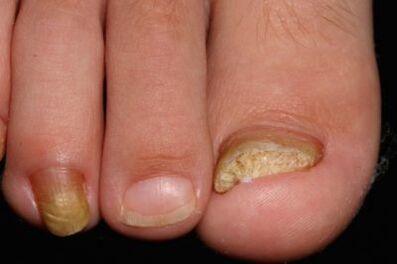
Onychomycosis is a disease in which the structure of the nail plate and the epidermal layer is disturbed.The surrounding tissues (skin roll) are involved in the pathological process.The nail is arranged in such a way that the cells are closely pressed against each other, forming a dense surface.Under the nail plate, the matrix and the blood vessels, surrounding the bone phalanx are placed.The upper layer is represented by Hyponichia, and at the base of the nail, there is eponichia.With nail mycosis, the pathogen affects the lower layers of the nail to the matrix.At the same time, the divided cells destroy the keratocytes and the nail plate thinks and brittle.Onychomycosis, in the absence of treatment, is accompanied by various complications and is difficult to give in to modern therapy.
Just over 50 types of dangerous fungal infections for humans are known.All have various morphological characteristics and parasitic stages.In order to finally identify the pathogen, a compulsory microscopic examination is carried out.
The nails on the legs are necessary to protect the soft parts of the fingers from injuries.Fashionistas paint nails of different colors, so yeast infection is also considered a cosmetic defect.With onychomycosis, the appearance of the nail is getting worse.The nail plates burst, break and destroy completely.The disease causes exacerbation of chronic systemic pathologies.
After entering the nail layer, the Causal agent begins to share actively, releasing new sons of Micelius.Due to air deficiency, mycelium applies to healthy nail and skin areas.The disease should be diagnosed and treated.
Types of disease
Several types of pathogens are distinguished, which affects legs on the legs.Classify parasites according to morphological characteristics and clinical signs.
- The trichophyte is red - a fungus that has a branch and litigation on the wires of the mycelium.The location of the process is the responsibility of the epidermis, raw parts (keratinized) of the cells.A specific feature of red trichophyton damage is the rigor of the tissues.Light spots and scratches are disparate, then merge.In the thickness of the skin cells, mycelium is compacted, stretched and forms disputes that can withstand the methods of various treatments.When coloring the nail medication under a microscope, the trichofiton structure is clearly visible.
- The epidermophyte is in the form of microorganism in the shape of a flap which causes nail mycosis on the legs in the form of skin coat, itching inter-back space and nail stratification.Unlike Trichophyton, Epidermophyton develops in several directions of their spore cell, so the location of the process is blurred.Mycelium of various thicknesses: delicate thin and short.When studying a microscopic drug, spores and part of the mycelium are compared to the flakes.The infection of the epidermophyte is accompanied by a change in the pigmentation of the nail and its progressive destruction.The infectious process begins both from the edge of the nail plate and its base.In addition to the yellow of the patient's nail plate, increased drought and rapid keratinization are worried.
- Mentagrofitet is one of the brilliant representatives of Trichophyton.It is less common, it affects the skin of the feet, the nail rolls of the legs and the nail plate itself.The causal agent enters the lower layers and is able to reach the underwater - matrix epidermis.Causes a seal of the corneum stratum and delicate parts of the nail.Statistics show that almost 20% of fungal infections are in Trichophyton Mentagrofitset, 80% is Trichophyte Rubrum.Onychomycosis caused by mentagrophytes contributes to the development of allergies, to the formation of vesicles and bubbles of the affected epidermis.
- Trichophyte Rubrum is a stable microorganism with external factors, but more often than not, it affects the skin of the legs.The causal agent for a long time has been on the insole of the patient's shoes and socks.In most cases, it is with other representatives of onychomycosis.
- The yeast microorganisms are the most famous as a candidate.Candidiasis is found on nails, skin and mucous layers.With nail mycosis, candidates cause specific symptoms and various degrees of destruction of Keercites.After carrying out research, scientists came to the conclusion that the candidate rarely becomes the main cause of mycosis, however, on the context of a decrease in local immunity, the fungus is introduced into the nail microtrauma and "dissolves" disputes.The fungus of the fungus is long, thin, branched.In a microscopic increase, the Skein of Mycelium and many disputes are found.Onychomycosis caused by candidates is accompanied by the formation of injuries, a change in form and color of the nail.One of the types of candidiasis.A notable characteristic of the disease is the main formation of a dark spot on the surface of the nail.In the future, the place increases - the nail becomes fragile and moves away from the matrix.
- Skopulariopsis is a less common type of nail mycosis.Similar to candidiasis, but also has significant differences in morphology.Small black dots appear on the surface of the nail plate.In the thickness of the nail, the formation is much wider and darker.The propagation of points leads to the relaxation and destruction of the nail.

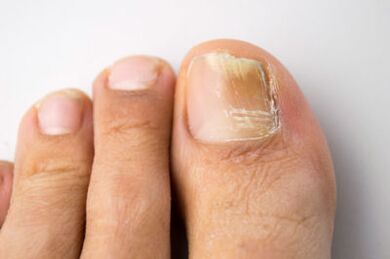
The characteristics of the pathogen species contribute to the good diagnosis of the disease.However, to make a final diagnosis, it is not enough to know the clinical characteristics of the infection.For this, pathogen must be differentiated.
Causes
The main reason for onychomycosis is the penetration of the fungus into keratocytes or epidermis.This process is present for the following reasons:
- a weakened immune system due to prolonged use of antibacterial drugs (general and local action);
- Direct contact with infection: current household items, visit swimming pools or public saunas;
- the presence of chronic diseases of the endocrine system and the thyroid gland;
- Systemic pathologies of the extremities: thrombosis, atherosclerosis, extension of varicose veins, trend for thrombophlebitis;
- herpetic infection which contributes to the fall of the defenses of the body;
- Gastrointestinal diseases and muscle pathologies;
- age -related changes.
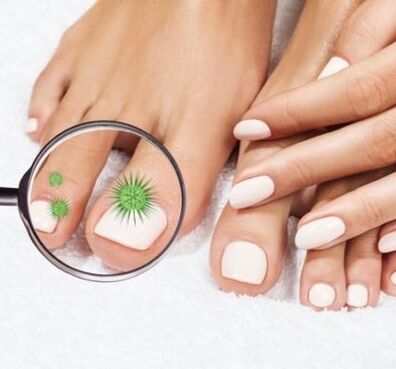
Nail mycosis can be the result of poorly selected shoes and underwear.
Be careful!The wearing of synthetic quality socks leads to an air deficiency, which creates the "soil" for the spread of mycoses.
Closed shoes and shoes are not seasonally, the absence of leg hygiene and the use of common manicure tools often lead to onychomycosis compared to chronic diseases.
Symptoms
You can suspect nail mycosis in the presence of signs such as:
- Small itching and burns.
- Peeling of the skin and redness of the Interdigital Space.
- The tightening of the nail and the appearance on the surface of small points, cracks or rigor.
- Unpleasant smell and pain appear with efforts on the toes (during running, walking or shoes).
The pathology develops quickly and, after a minor period, the patient is concerned with the fragility, relaxation and pigmentation of the plate.In the absence of treatment, a yellow-green or dark brown shade appears, the hyperemia with rollers, the burn of the epidermis and the disappearance of the nail shiny.All these signs indicate various degrees of nail damage.
The degree of damage to the legs on the legs
The nail fungus on the legs is classified according to the degree of intensity of clinical signs.There are only three degrees of pathology:
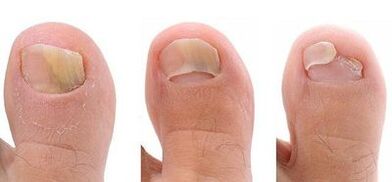
- Initial or normotrophic degree.The infection focuses on extreme fingers.The plate has a slight stratification or light pigmentation.
- The hypertrophic degree is characterized by the development of clinical signs.Patients note pain, increased perspiration and the presence of an unpleasant odor.The nail is compacted and colored.
- The atrophic degree is the most dangerous form of pathology, because all the layers of the nail and the matrix are involved in the pathological process.Atrophic changes are captured by neighboring parts of the skin and a roller.Due to significant destruction, the risk of bacterial infection and the development of purulent processes increase.Treatment of treatment can cause sepsis or bacteria.
The type of disease is extremely important for a doctor because it allows you to determine the treatment method and prevent complications.
Diagnosis
Diagnostics or mycologists are engaged in diagnoses, as well as the treatment of the disease.To confirm the diagnosis, special studies are carried out:
- Microscopic study of part of the nail or scratch;
- Sowing for nutrients for the growth of the pathogen and the selection of therapy;
- Histological study of the skin medication to assess the degree of severity.
The doctor performs an external examination, collects the patient's history and his complaints.If necessary, he recommends taking a general blood test.
Diagnostic manipulations take some time, because part of the nail is placed in special solutions to dissolve cellular elements and study the morphology of pathogens.It is impossible to make a diagnosis only by external signs, we can only assume only a pathogenic pathogen.
After diagnosis and in -depth evaluation of the severity of the disease, the treatment method is determined.
Treatment of nail mycosis on the legs
Mycosis therapy of the nails on the legs depends on the condition of the patient and the degree of destruction of the nail plate.The main objective of treatment of nail mycosis is the complete elimination of the patient's patient and persistent relapses.Treatment tactics and therapy method are determined by the doctor.
Medicine

The most common treatment method is the use of drugs.The following pharmaceutical groups are used in therapy:
- The Paulines are tablets that destroy the DNA of the parasite and its mycelium.It is recommended to receive funds for at least 14 days.
- Azols are drugs that inhibit the growth of pathogens and prevent their reproduction.
- Alllamins are long -term drugs used at advanced stages.Due to the minimum of contraindications, drugs succeed.
The above drugs have several dosage forms: tablets, capsules, creams and sprays.Antifungal drug therapy is carried out both from the inside and the outside.The course of treatment is determined by the doctor.In addition to specific means, antiseptic solutions for washing, antibiotics and wound healing are prescribed.Doctors advise to gradually get rid of the affected plate: cut or cut the edges, use a special patch.
Surgery
If a conservative treatment has not given positive results, they use surgery.The intervention is carried out using the laser rays to remove the growth of the pathogenic microflora.The procedure is carried out in several stages.
Traditional medicine
Non -traditional recipes are used to rinse wounds and increase local immunity.It is impossible to eliminate the fungus with folk methods, but it is possible to weaken the pathogen of mycosis.
- The most famous and common method is baths and compresses with soap on tar.
- Famous baths with sodium bicarbonate and salt - eliminate bacteria and exercise antiseptic properties.
- Lemon juice and propolis.The nail is lubricated with juice and a compress is prepared from propolis.
- JUI of Célinine and vinegar diluted with water.
- Iodine lotions.
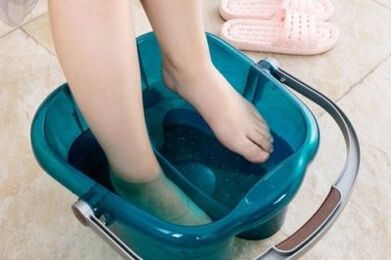
However, popular methods are used with drug treatment to prevent complications, non -traditional treatment methods with a doctor should be coordinated.
Prevention
Preventive measures can avoid infections and reduce the risk of relapse of the disease.The patient must eat properly, observe the hygiene of the legs, do not put someone else's shoes and use a common towel.When you visit saunas or swimming pools, put personal rubber slippers and rinse them at home.
Leg nails mycosis is an unpleasant and dangerous disease.The infection can enter deeper layers and impress the nail plate and the matrix.It is easier to prevent the disease than to deal with, but when infected, the patient must look for as soon as possible for qualified help.Creams, varnishes and special tablets allow you to stop the growth of mycelium and destroy the cell wall.It is important to understand that the treatment is long, so you should wait for the therapeutic effect as soon as possible after 3 weeks.























